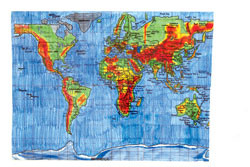 You know, if it isn’t global warming, it’s bad spinach. Or crooked congressmen and no good nannies. It’s always something. And now . . . geography?
You know, if it isn’t global warming, it’s bad spinach. Or crooked congressmen and no good nannies. It’s always something. And now . . . geography?
Yes, geography is just one more thing that’s confounding the U.S. Turns out we don’t know anything about it.
A well-publicized National Geographic-Roper study released earlier this year showed that nearly two-thirds of Americans aged 18-24 can’t find Iraq on a map. Can’t find Iraq! And 88 percent can’t find Afghanistan. Not to mention Israel and Iran. Those two I’s might as well be hiding over behind Surinam.
But it isn’t just far-away places. Here at home, half the young men and women couldn’t locate New York and 57 percent couldn’t find Ohio. That doesn’t surprise Collegiate Middle School social sciences teacher Rick Haas. "It’s not just students, or young people; it’s the general population that doesn’t know much about geography," he says. "The same sort of studies that show people can’t find Iraq would also show they don’t know what country we won our independence from."
France? Just kidding.
But what’s new? Who could’ve found Normandy before World War II? And how much does this lack of geographic knowledge really matter? It matters more than ever, says Keith Mountain, professor and chairman of the department of geography and geosciences at the University of Louisville. "A classic example would be — and I don’t know how you could phrase this away from the political arena — the issue in which we find ourselves in Iraq," he says. "If you listened to the way it was presented in the early years, before we engaged ourselves in that country, the administration of that time clearly thought of Iraq as a simple geographic boundary. But what we’re seeing, and what was not appreciated at that time, is the role of cultural identity . . . and it was never accommodated. We never understood the geography of that country."
The Roper study was conducted on a group of young people the National Geographic Society and its researchers had followed for over a decade, in nine countries, and reflected what they had learned — or not learned — in school. "But," says Mountain, "what’s interesting from the outcome of those reports is not whether the person got the question right or wrong, but what (else) you don’t know if you got it wrong." In other words, beyond the facts tested for in the survey is a wealth of physical, cultural and economic information that might be crucial to trading with or influencing other countries.
In a ninth-grade honors class at St. Xavier High School, teacher Michael O’Toole poses a question about North American geography. A couple of hands shoot up. An answer is offered and that leads to more discussion and more hands raised — plenty of classroom enthusiasm considering it is the twilight of the teaching week: last period on Friday afternoon.
O’Toole is working with a PowerPoint computer-projected slide show — kind of like your old art history class where the professor shows a slide of Titian’s cherubs then talks about it. Only O’Toole’s show is better. He mixes photos and maps with on-screen lesson notes. All the while, he suggests that students call upon their own knowledge to illustrate the geographic themes under discussion. And they do.
O’Toole shows photos he’s taken in the high mountain terrain of Colorado’s Rocky Mountain National Park, with snow on the mountaintops even in summer. Then we’re among the huge sequoias at Sequoia National Forest, in California. And yes, there’s a car driving through a "tunnel" cut through one of the ancient trees’ trunks.
A hand goes up. "If the United States had been settled west to east, would there be more national parks in the East than the West?"
Now there’s a question. For an answer, O’Toole swings the discussion to the differences between the geographies of the Eastern and Western U.S. — how the East is better suited for large cities, with better water supply, flatter land. How it had natural ports and large rivers when waterways were the primary avenue of movement. He and the students talk about steam power and industrialization in the young United States.
For homework, O’Toole can structure assignments around visits to Internet sites such as KET.org’s "Encyclomedia" pages and National Geographic’s MyWonderfulWorld.org. With a few clicks of the mouse to NOVAonline.com we were inside the Great Pyramid of Cheops, walking with lantern and a hand-held camera, through labyrinthine rock passageways to the tomb of King Khufu.
Then we went to the top of Mount Everest, where there is a camera on a turret that we could control with the mouse — able to look off in every direction from the highest spot in the world.
Cool. That’s the only word for it.
The freshmen students seem to thrive on the visual stimulation. "The one thing kids hate is to read books," says O’Toole. "But they’ll read all the text there is on a screen."
Educators agree that travel broadens horizons and raises the level of geographic curiosity. Which is a big advantage at private Collegiate School, says Haas, who a couple years ago accompanied a group of Collegiate students on a tour around the Adriatic Sea, with stops in Italy and the Greek isles. This year some Collegiate students will be off to Costa Rica, and there’s a special spring-break exchange with Germany. Language learners spoke French for a week when they traveled to Quebec City.
"And we’re particularly lucky here that we have kids from foreign backgrounds," Haas adds. "We have a student from the Middle East who is Palestinian, who has lived in Saudi Arabia. And we have African kids. One student grew up in Rwanda, a country which has had so much tragedy. But he isn’t focused on bitter memories. He likes to talk about the beauty of the rainforest."
Of course, there are many area students whose families just don’t have the economic means to travel, including the city’s most disadvantaged. In the Jefferson County Public Schools system there are 6,000 children who are homeless and sleep in shelters every night. Many children have never been outside of Louisville. Never even crossed the Ohio River.
But disparities of experience are a part of every classroom, and the travel excursions of some can pique the curiosity of others. Not many kids have been to Stonehenge, but some have been to Mount Rushmore. Or Chicago. Or the Great Smoky Mountains — the country’s most visited national park.
For most kids, elementary school offers the first discovery of the wide world.
That’s where Beverly Calloway comes in. Fourth grade is the first formal presentation of geography for all of the school district’s elementary students. At Watson Lane Elementary, Calloway teaches fifth grade, and tries to keep the flames of geographic discovery burning.
"We have projects, talk about early explorers and Native Americans, and discover the themes of geography," Calloway explains. "We find where the Native Americans were. How they moved. How settlers acquired territory. We follow Lewis and Clark blazing a trail to the Pacific — and think about when they first saw the Rocky Mountains. They must have said, ‘Wow!’
"What we want to do is tie geography into history as a story. Learning the connections. That’s especially important for children."
Especially helpful in weaving the stories, she says, is her classroom’s set of Nystrom relief maps and atlases, as well as globes with geographic features in relief. "Looking at a flat book doesn’t mean as much to little children as being able to run their fingers across mountain ridges and through valleys," Calloway says.
"We encourage parents to take their kids places," she adds. "It helps them learn directions, and make connections between things — where things are and how they connect. Just to drive by the Ohio River, they might not make think about it. But we talk about the river and how it connects them with the world."
To help Calloway and other primary and secondary educators do their jobs, U of L’s Mountain has helped create the Kentucky Geographic Alliance, headquartered at the University of Louisville and Western Kentucky University. "It operates at the collegiate level as a resource for teachers in grades P through12 for geographic information, educational materials — anything that would place geography in the curriculum," he says.
Collegiate’s Haas says that different school boards place different emphasis on geography. "There’s more knowledge of mathematics than there is of geography," he says. "It’s not a top priority.
"Everybody says geography is important, but I don’t know how much of that is translated into making sure every student gets a good geographic education. It’s really like any subject: It takes either an involved parent, or a really good teacher, or a good book, or a curious kid to instill the need to learn about anything."
To stoke his students’ coals, O’Toole employs a tool he got from his high school geography teacher, Rick Sorrels, now a guidance counselor at St. Xavier. "As a freshman at St. X," O’Toole says, "I took part in a project called the World Memory Map, and it’s what made me want to be a geographer."
At the beginning of the school year, O’Toole asks his ninth-graders to use models to draw maps of the world — maps that, of course, turn out pretty crude. But as the year progresses the students continue to draw maps of what they’re learning — around the world, region by region. Then, at the /files/storyimages/of the year, O’Toole asks them to draw one big world map — by memory — filling it in with all the details they wish. The creations from past classes are astoundingly respectable-looking.
"You can always point something out on a map, but if you can draw it, and draw it accurately — with correct latitude and longitude — and then detail it, you really know it," explains O’Toole. "It’s a challenging project to reproduce the world by memory."
O’Toole says his job is "to open these kids’ eyes to the world. Let them form their own ideas about people of the world and different cultures, and do that properly. I ask them to think big and say, ‘One day I would like to go there.’"
Pop Geography Quiz
Think you know geography? Here’s a little test we put together especially for you.
1. What country is the United States’ biggest trading partner?
2. What’s the significance of the "38th Parallel"?
3. There are two important Georgias in the world. One is south of Tennessee; the other is south of .............
4. Four state capitals of the U.S. are named for presidents. What are they?
5. What three countries besides Turkmenistan, Uzbekistan and Tajikistan border Afghanistan?
6. Name the four rivers that border Kentucky.
7. What and where is the world’s highest waterfall?
8. From what country does the U.S. import the most oil?
Answers:
1. China.
2. Separates North and South Korea.
3. Russia.
4. Jefferson City, Mo.; Jackson, Miss.; Lincoln, Neb.; Madison, Wis.
5. Iran, Pakistan, China.
6. Ohio, Mississippi, Tennessee, Big Sandy.
7. Angel Falls, southeastern Venezuela (3,212 feet).
8. Canada.
PULLQUOTE
"There’s more knowledge of mathematics than there is of geography," says haas. "It’s not a top priority."


